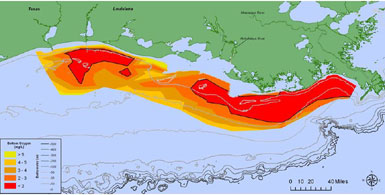We are pleasantly surprised to hear that work is proceeding to clean up the enormous dead zones in the Gulf of Mexico.
Nitrogen and phosphorus in fertilizers enter the Mississippi River watershed from the nation’s farms, creating algal blooms which consume all the oxygen in the water by the time it reaches the Gulf.
12 states are participating in a "Hypoxia Task Force" led by EPA. The goal is to shrink Gulf dead zones two-thirds by 2035, from the astounding 6000 square miles it averages today – about the size of Connecticut.
The dead zone runs from Texas to Louisiana:

Each state has developed a plan to prevent runoff from farms, storm water and wastewater treatment plants. For example:
- Minnesota is providing $221 million in grants to restore watersheds, and to protect ground water and drinking water.
- Wisconsin is funding expanded use of conservation practices in 45 agricultural watersheds and critical sites in the Mississippi River Basin
- Illinois Fertilizer Act charges a tax of $0.75 per ton of bulk fertilizer for research and educational programs focused on nutrient use and water quality.
The Task Force is also developing tracking mechanisms to measure progress, such as computer modeling and watershed monitoring. Cleaning up the dead zone is also part of the Gulf Restoration Plan, developed after the BP Horizon oil spill.
Members of the Hypoxia Task Force are: Army Corps of Engineers; Department of Agriculture; Department of the Interior; EPA; National Oceanic and Atmospheric Administration; and the states of Arkansas, Illinois, Indiana, Iowa, Kentucky, Louisiana, Minnesota, Mississippi, Missouri, Ohio, Tennessee, and Wisconsin. Tribes are represented by the National Tribal Water Council.
Sadly, for the past few decades, dead zones have been increasing across the world – there are now more than 550, with 43 in US waters. The Baltic Sea has the largest dead zone, followed by the Gulf of Mexico.
Read our article, Farmers Turn to Floating Islands to Cut Pollution.
Learn more at EPA’s Gulf Hypoxia website:
